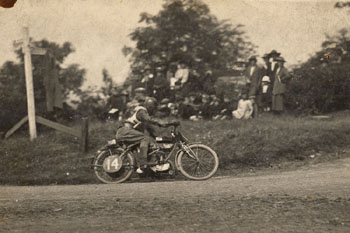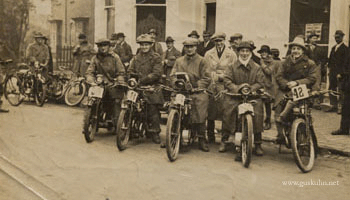|
GUS KUHN, still riding his 2¼ Levis, gained a first-class award in the 1920 Colmore Cup Trial. A short sporting course, a fine day, an early start and good organisation. All these helped to make a success of the Sutton Coldfield and North Birmingham Club's event. A subsequent report stated: "Gus's Levis literally sang with a very musical note up the observed Saintbury Hill and its accelerative powers were probably equalled only by the ABC machines. His machine must be 'very special', judging by its resonant explosive 'puffle'."
Four weeks later, in early April, the little Levis was put to another test - that of hill-climbing, and once again it performed wonderfully well in the Essex Club's Open event at Kop Hill near Princes Risborough. On form, Gus gained three seconds with a win in the Class D event. He was certainly a glutton for the motorcycle sport for the following day we find him competing in the Sangster Cup Trial, a Birmingham to Barmouth trip which included the notorious Bwlch-y-Groes test hill on which with other riders, Heath, Dalby and Duke, Gus made a star solo climb. The two-stroke Levis was given an outing on the sands at Weston in the Bristol Clubs Speed Trial in Early May after which, in the following month Gus would ride in the Junior TT race in the Isle of Man. Now chain-driven his machine brought him into seventh position at the finish and he averaged 35.43 mph, over five laps of the 37 mile course. Cyril Williams (2¼ AJS) proved the winner at 40.74 mph, but in the incorporated 250cc class Gus was placed second. Not content with their strenuous efforts in the TT races, most of the riders with surviving machines, took part in the subsequent Kilometre Speed Trials held on the Douglas promenade. While the 2¼ hp machines such as George Dance's Sunbeam were clocking speeds of over 75 mph, the other categories were making fine performances and Gus made the fastest time (43s) or 51.78 mph, in the 275cc class, while in the 350cc class he made an even higher speed - 53.26 mph. Reliability Now came the toughest reliability trial of the year in August - the ACU Six Days Trial held mainly in Yorkshire. Forty different makes of motorcycles were represented in this great annual event. An entry of 139 names came in out of a limited 150. Actually there were 133 starters which included Gus Kuhn on the Levis with F.W.Applebee and F.Porter riding identical models of 247cc and entered by the manufacturers, Butterfields Ltd. This trio formed the Levis team and no trial would be complete without such a team, their machines having the same engines as used in the TT. On Park Rash - the worst hill on the first day's run which had an exceptionally loose surface and a maximum gradient of 1 in 4 - they had plenty of power, but their speed was too high on the atrocious surface, and so, to prevent being buffeted about on the road, the models were reduced in speed by altering the gear ratios. Right from the commencement of the 919 mile super trial, the hills were severe in the extreme, as those acquainted with the Yorkshire and Northumbrian districts agreed. Writing at Darlington from a recollection of some of the hills which at one time were accepted as freak climbs, the conditions proved quite the most difficult yet encountered. Judged as a whole, the various machines - and they included Zeniths, Humbers, Ariels, Velocettes, Sunbeams, Harley-Davidsons, Triumphs, N.U.T.'s, Nortons, James, Clynos, Diamond, Scotts, BSA's, Indian Scouts and Rovers, to quote but a few - were magnificent. In the lightweight class for engines up to 275cc was a total of 14 including the Levis team. But the arduous course did not favour the lightweights. Mountain tracks, which no sane man would ever dream of traversing awheel in the ordinary way, were there to transmit shocks and exert the greatest possible stresses on frames and fittings. Nevertheless the lightweights put up some superb performances although there were five retirements. Gus Kuhn and team-mate F.Porter each won a Gold Medal. 'Pa' Applebee, third member of the Levis team, unfortunately retired on the penultimate day's run of 204 miles. Taking part in the memorable trial were 95 solos and 38 combinations which included three Morgans. Out of the 133 starters 33 retired. Awarded were: 88 Gold Medals, five Silver Medals and one Bronze.
This particular "super-endurance" trial was without doubt the most severe in the history of the Six Days. To have won a Gold Medal - as Gus Kuhn did (now 22 years old) - proved an award of which he was justly proud. Organised by the Birmingham M.C.C. the Olal Lightweight Trial, the course of which was six circuits of the "Farlow Loop", was won by Gus on his customary Levis. And his award - quite an unusual one - was a sideboard! Its value: 26 guineas. You'll see the start of this particular trial in the accompanying picture.
It is interesting to note that the makers of Gus Kuhn's Levis 2-stroke tested two identical machines for petrol consumption over a 25-mile course. One machine was standard in every respect and its consumption with a total weight of 252 pounds worked out at a rate of 164 miles per gallon. The other mount had a specially tuned carburettor, and with its rider weighed 282 pounds, yet the mileage was equivalent to an amazing 226 mpg! An ACU engineer officially observed the trial. Gus Kuhn's super-motorcycling ability had been highlighted throughout the year which had been one of exceptionally severe trials; freak hills and boulder-strewn gulleys, often causing the riders of lightweight machines to be more productive of protests than prizes. Indeed, the whole future of reliability trials hung in the balance on account of this severity, which threw the skill of the rider into undue prominence. Lightweights Gus, of course, on account of his little Levis 2-stroke, was a lightweight addict and in dealing with the lightweights it had to be acknowledged that trials had at least one useful purpose, apart from the stock claim of "improving the breed". They had clearly demonstrated to an extraordinary degree the capabilities of the lightweight: so much so, indeed, that many now considered that this type of motorcycle would survive solely as the ultimate solo mount. Early in the year some of the more pronounced successes of the lightweight were registered by miniatures of 211cc and 250cc, when the running of the little James and Levis 2-strokes in the Colmore Trial were so favourably commented on. Then came the Victory Cup Trial (a great favourite of Gus Kuhn's) and, repeating the 1919 success, when a Levis secured the chief prize, a small machine (a 2½ hp Diamond this time) gained the premier award from a field of 165, which included most makes and types of machine. The classic London to Edinburgh run had previously been an annual joyride, but this year the inclusion of the Kirkstone Pass in the Lake District, considerably upset this comfortable viewpoint. Therefore the presence of a genuine lightweight, the Levis, amongst the only six firms to gain 100 per cent success was an excellent tribute both to the type and to Butterfields Ltd, whose product, a pioneer in its way, had done incalculable good in removing the public prejudice against the small machines. Several trials however, had been confined solely to lightweight models and one or two were really stiff tests, for example the Birmingham M.C.'s trial for the Olal award which, as I have already said, was won by the redoubtable Gus Kuhn. This short relation by no means exhausts the roll of honour of the lightweight - practically every 1920 trial, open or closed-to-Club, furnished some example of the smaller machine, if not beating, at any rate equalling, the field - but it touches the majority of the more important and therefore more difficult events. Even the smallest machines that took part in the ACU Six Days Trial demonstrated their ability to last through a very arduous event and to prove themselves to be capable of going anywhere. In the run from Darling to Thirsk, a distance of 79 miles, the petrol consumption of Gus Kuhn's Levis (2¼ hp) was 101 mpg. Severe Conditions After 918 miles of riding under very severe conditions, several tests were carried out at Brooklands and particular mention was made of the performance of Gus's Levis and also of a Scott, Velocette, AJS, Matchless, Humber and Beardmore Precision. Brake tests were carried out on the Test Hill, silencer tests were also carried out as well as the speed test during which each machine travelled for half-an-hour at a speed determined by its class. This was a very popular inclusion in which Gus's Levis came through with "flying colours" although four marks were lost in the silencer test and one in the brake test. Gus Kuhn had proved throughout the year that the Levis 2-stroke was a very fine sporting solo mount: to his delight he had gained many awards in the varying aspects of the sport. Now he could justly take the name of "Versatile Gus". While Gus was enjoying himself in competitive events, American Dirt Track racing was all the vogue. Ralph Hepburn on a 7-9hp Harley-Davidson had won a 300-mile race on the two-mile Dirt Track at Dodge City at 85.69 mph! An Indian machine was second in that particular race, while other Harleys occupied third, fourth, fifth, seventh and eights positions. Dirt track racing in America was super-thrilling and super-exciting: of this there was no doubt. Their racing machines were of very special design - fragile, delicate, short-lived and very impracticable for ordinary road use. They had been over-developed; compressions had been raised, and the general overall efficiency raised until the machines were capable of terrifying speeds far in excess of the limits of safety of the tracks. Albert "Shrimp" Burns was the mainstay of the Indian racing team, and just three weeks before he had met on a mile dirt track at Kenosha, the cream of the Harley-Davidson racing contingent on 8-valve models, and, single-handed, he outrode and vanquished them in three events. Many lives had been sacrificed in the quest for speed .. and still more speed but the show had to go on, the hazards and the risks still being exploited, and the American factories spending huge amounts of money in supporting race meetings. On August 14, Albert Burns met an untimely end in a race meeting on the mile dirt track at Toledo, Ohio. But with old-time American enthusiasts he still lives on ... in memory. |

